Die Burgen von Burgund / The Castles of Burgundy
Author: Stefan Feld
Publisher: Alea/Ravensburger
Year: 2011
review by

| x |
|
|
|
|
|
|
|
|
|
|
|
|
|
|
|
|
|
|
|
|
|
|
|
|
|
|
|
|
|
|
|
|
|
|
|
|
|
|
|
|
|
|
|
|
|
|
|
|
|
|
|
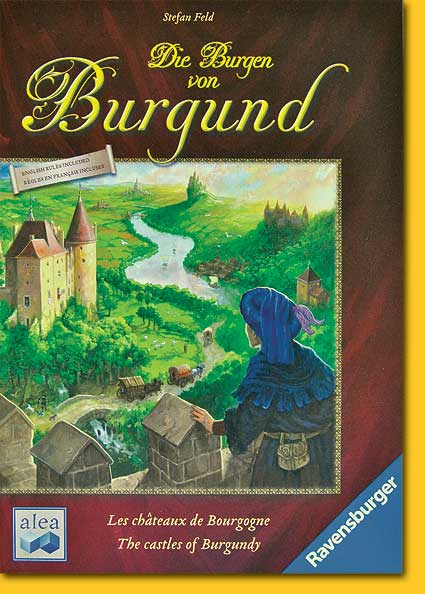 |
To live as a king in Burgundy, how sweet would that be? Well, this dream seems to be fulfilled by 'Die Burgen von Burgund' / 'The Castles of Burgundy', as in the game the objective is to establish an estate that is the nicest and greatest of all players. Players try to accomplish this by building castles, mines and buildings, by sailing their ships on the Loire River, by farming livestock, and by stimulating scientific research. The development is measured in victory points, and the player with the most points at the end will be crowned as winner.
|
|
|
|
|
|
|
|
|
|
|
|
|
|
At the start of the game each player receives his own player board which features the estate that needs to be established. The estate consists of 37 empty spaces, split into regions of six different colours. Each player receives the same estate, but for a variant a total of 9 different setups are available. Each space of the estate also shows one side of a die. The players are also given two dice in their player colour, three random good tiles, 1 money called Silverlings and, depending on the initial turn order, a number of worker tiles. Playing pieces in the player’s colour are placed on the victory point track and the turn order track of the central game board. As a start of the player’s estate an initial castle is placed on the player’s game board.
|
|
|
|
|
|
|
|
|
|
|
|
|
| x |
|
|
|
|
|
|
|
|
|
|
|
|
|
|
|
|
|
|
|
|
|
|
|
|
|
|
|
|
|
|
|
|
|
|
|
|
|
|
|
|
|
|
|
|
|
|
|
|
|
|
|
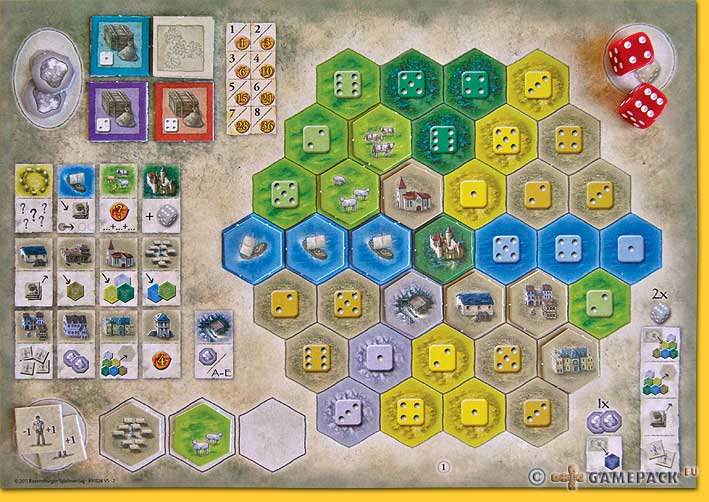 |
|
|
|
|
|
|
|
|
|
|
|
|
| x |
|
|
|
|
|
|
|
|
|
|
|
|
|
|
|
|
|
|
|
|
|
|
|
|
|
|
|
|
|
|
|
|
|
|
|
|
|
|
|
|
|
|
|
|
|
|
|
|
|
|
|
|
The game is played in five phases (A through E), each consisting of five rounds. At the start of each phase five random good tiles are placed face-up on the central game board. Furthermore, six-sided tiles are randomly drawn and placed face-up on the matching-coloured spaces around the six numbered depots on the central game board. The number of tiles depends on the number of players. In the central 'black' depot a number of six-sided tiles is placed as well, drawn from the stock of special black tiles.
|
|
|
|
|
|
|
|
|
|
|
|
|
| x |
|
|
|
|
|
|
|
|
|
|
|
|
|
|
|
|
|
|
|
|
|
|
|
|
|
|
|
|
|
|
|
|
|
|
|
|
|
|
|
|
|
|
|
|
|
|
|
|
|
|
|
 |
|
|
|
|
|
|
|
|
|
|
|
|
| x |
|
|
|
|
|
|
|
|
|
|
|
|
|
|
|
|
|
|
|
|
|
|
|
|
|
|
|
|
|
|
|
|
|
|
|
|
|
|
|
|
|
|
|
|
|
|
|
|
|
|
|
| At start of a round all players roll their two dice. The start player also rolls a white dice, which determines to which of the six depots the round’s good tile is allocated. In turn order, determined by the turn order track on the central board, the players now perform their two actions. For each dice roll four actions are possible, and the dice rolls determine to a large extent what the possibilities are. One possible action is to take a six-sided tile from the depot that corresponds with the result of one of the dice. This tile is for the moment placed in the player’s storage, which consists of three spaces. A second action could be to place a tile from the player’s storage into the estate space, on a space corresponding with the result of one of the and that has the tile’s colour. The tile also has to be placed adjacent to a tile already built. |
|
|
|
|
|
|
|
|
|
|
|
|
| x |
|
|
|
|
|
|
|
|
|
|
|
|
|
|
|
|
|
|
|
|
|
|
|
|
|
|
|
|
|
|
|
|
|
|
|
|
|
|
|
|
|
|
|
|
|
|
|
|
|
|
|
 |
The third possible action is to sell the goods; now the dice roll has to correspond with the good type that the player owns. The good tiles immediately score points: 2, 3, or 4 points per tile, depending on the number of players. In addition, the player receives 1 Silverling. This money can be used to buy a special tile from the central black box, but this is only possible once per turn. |
|
|
|
|
|
|
|
|
|
|
|
|
| x |
|
|
|
|
|
|
|
|
|
|
|
|
|
|
|
|
|
|
|
|
|
|
|
|
|
|
|
|
|
|
|
|
|
|
|
|
|
|
|
|
|
|
|
|
|
|
|
|
|
|
|
| As a fourth possible action, the player can take two worker tiles, independent of a die result. These worker tiles give a player flexibility; by using them any dice roll can be modified by 1, so a 4 roll van be changed to a 3 or a 5, and a 6 to a 5 or a 1. As the depots are only refilled at the beginning of a new phase, the use of workers to modify a roll can be very convenient, when some depots are already empty or contain unwanted tiles. |
|
 |
|
|
|
|
|
|
|
|
|
|
|
|
| x |
|
|
|
|
|
|
|
|
|
|
|
|
|
|
|
|
|
|
|
|
|
|
|
|
|
|
|
|
|
|
|
|
|
|
|
|
|
|
|
|
|
|
|
|
|
|
|
|
|
|
|
 |
The heart of the game is formed by the six-sided tiles that are built in the player’s estate. Each of the six possible tile colours give an advantage of some kind. In general, when a player has completed a region by occupying it with the appropiate tiles, it scores ranging from one victory point for a completed region of one space to a maximum of 36 for a region containing eight occupied spaces. Besides this a player also scores for completing an area, independent its size. The points awarded for this are dependent of the phase in which it is completed, decreasing in each next phase, so the sooner an area is completed, the better. Another bonus is scored for the first two players who complete all regions of a specific colour. So there are a lot of ways to score points!
|
|
|
|
|
|
|
|
|
|
|
|
|
| x |
|
|
|
|
|
|
|
|
|
|
|
|
|
|
|
|
|
|
|
|
|
|
|
|
|
|
|
|
|
|
|
|
|
|
|
|
|
|
|
|
|
|
|
|
|
|
|
|
|
|
|
|
In the dark green regions the castles can be built. After placing a castle, any additional action may be performed by the player.
A blue ship tile must be placed on the river, and moves the player one step ahead on the turn order track. Furthermore, the player can take all good tiles from any depot on the game board, and place them face-up in his own storage. The good tiles later can be sold for money and points.
The animal tiles must be placed on the light green spaces and score points immediately, in a cumulative way when animals of the same type are already present in the same region. For instance when a 3 cow tile is placed in a region where a 4 cow tile already is present, the player gets 7 points in addition to the 4 points received earlier.
The grey regions are for mining. For each mine a player gets 1 Silverling at the end of each phase.
|
|

|
|
|
|
|
|
|
|
|
|
|
|
|
| x |
|
|
|
|
|
|
|
|
|
|
|
|
|
|
|
|
|
|
|
|
|
|
|
|
|
|
|
|
|
|
|
|
|
|
|
|
|
|
|
|
|
|
|
|
|
|
|
|
|
|
|
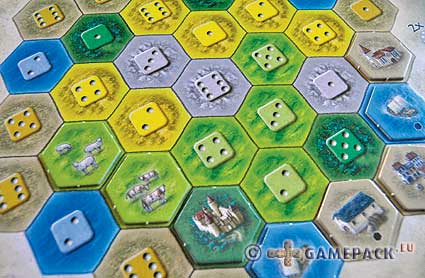 |
|
The beige regions represent cities and the building tiles are placed here. There are 8 different buildings, each with its own advantage. Placement of the wharehouse for example, allows a player to sell goods without having to spend the result of a die to it, and by placing a bank to the estate a player immediately gets 2 Silverlings, enabling the immediate buy of a 'black tile'. All buildings in a region must be of a different type.
  
|
|
|
|
|
|
|
|
|
|
|
|
|
| x |
|
|
|
|
|
|
|
|
|
|
|
|
|
|
|
|
|
|
|
|
|
|
|
|
|
|
|
|
|
|
|
|
|
|
|
|
|
|
|
|
|
|
|
|
|
|
|
|
|
|
|
|
Finally, there is the scientific development, represented by the yellow tiles and regions. In total there are 26 numbered knowledge tiles, each providing its own specific advantage. Some give an immediate advantage during the game -such as getting two Silverlings instead of one when selling goods, others give bonus points at the end of the game for buildings or for selled goods.
|
|
 |
|
|
|
|
|
|
|
|
|
|
|
|
| At the end of the 5 phases players have performed 25 die rolls and 50 actions. Players score for unused Silverlings, worker tiles and unsold good tiles, and the yellow tiles. As usual, the player with the most victory points is the winner. |
|
|
|
|
|
|
|
|
|
|
|
|
| x |
|
|
|
|
|
|
|
|
|
|
|
|
|
|
|
|
|
|
|
|
|
|
|
|
|
|
|
|
|
|
|
|
|
|
|
|
|
|
|
|
|
|
|
|
|
|
|
|
|
|
|
| x |
|
|
|
|
|
|
|
|
|
|
|
|
|
|
|
|
|
|
|
|
|
|
|
|
|
|
|
|
|
|
|
|
|
|
|
|
|
|
|
|
|
|
|
|
|
|
|
|
|
|
|
| x |
|
|
|
|
|
|
|
|
|
|
|
|
|
|
|
|
|
|
|
|
|
|
|
|
|
|
|
|
|
|
|
|
|
|
|
|
|
|
|
|
|
|
|
|
|
|
|
|
|
|
|
 |
|
|
|
|
|
|
|
|
|
|
|
|
|
|
|
|
|
|
|
|
|
|
|
|
|
|
|
|
|
|
|
|
|
|
|
|
|
|
|
|
|
|
|
|
|
|
|
|
It is an illusion to think players can fulfill their French dream, or even get close to it, unless this dream is to score points in the French countryside. But this doesn't matter, as 'Die Burgen von Burgund' / 'The Castles of Burgundy' is a nice game that fits perfectly in the Alea tradition that confronts players with many options. For many it will be nice to hear that the game differs from the traditional 'Feld': there are no rats, disasters or other hardships that are to be endured; the game has a positive atmosphere, with the focus ahead, to score as many points as possible.
|
|
|
|
|
|
|
|
|
|
|
|
|
| x |
|
|
|
|
|
|
|
|
|
|
|
|
|
|
|
|
|
|
|
|
|
|
|
|
|
|
|
|
|
|
|
|
|
|
|
|
|
|
|
|
|
|
|
|
|
|
|
|
|
|
|
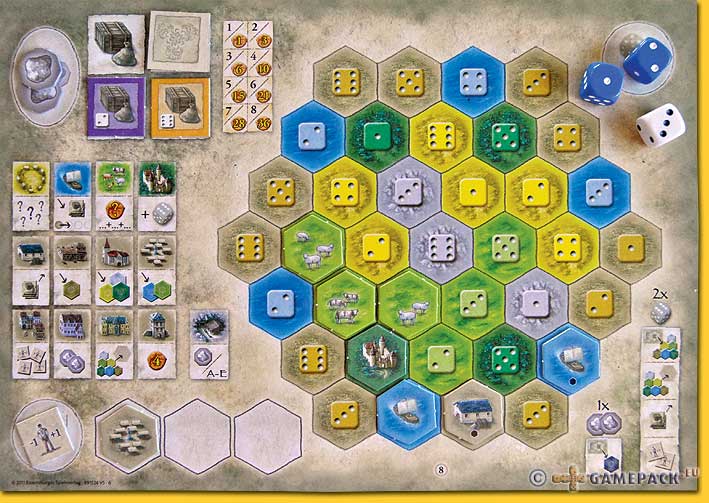 |
|
|
|
|
|
|
|
|
|
|
|
|
| x |
|
|
|
|
|
|
|
|
|
|
|
|
|
|
|
|
|
|
|
|
|
|
|
|
|
|
|
|
|
|
|
|
|
|
|
|
|
|
|
|
|
|
|
|
|
|
|
|
|
|
|
|
The puzzle is to optimise each turn as much as possible. Since the game offers a lot of options, this could lead to some paralysis symptoms with some players. Going first in a round is a big advantage, so building ships to try to become start player is always good, but usually there are a lot of other nice tiles available as well, sometimes enabling a chain of events. For instance, placing a castle gives an extra action with which the City hall could be built that allows an extra build action. Of course the dice roll not always shows the wanted result, and worker tiles are needed as modifiers. But eventually a player runs out of them, and then there has to be found a way to collect them or just deal with the roll. These kinds of small brainteasers result in long and slow player turns.
|
|
|
|
|
|
|
|
|
|
|
|
|
| x |
|
|
|
|
|
|
|
|
|
|
|
|
|
|
|
|
|
|
|
|
|
|
|
|
|
|
|
|
|
|
|
|
|
|
|
|
|
|
|
|
|
|
|
|
|
|
|
|
|
|
|
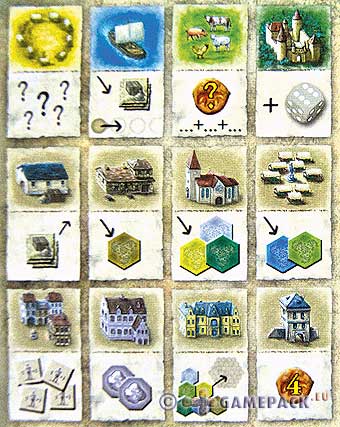 |
|
The game duration is much longer than stated on the box. The indicated thirty minutes for a two player game is very optimistic and may easily be doubled the first few games. With about 30 minutes per player the game can get a bit too long, especially with the maximum of four players. A caution should be placed on the box: 'Warning: game plays longer than indicated!'.
There are not many other complaints, other than the fact that the yellow and (light) green colours are too similar, causing confusion. And the player boards are a bit flimsy, but on the other hand this allowed more different boards to be included in the box.
With their range of 'big box' games, Aleas aims at their own crowd of experienced players with games that are generally considered quite complex. 'Die Burgen von Burgund' / 'The Castles of Burgundy' could be considered complex, but only due to its diversity and large scale of options, not due to rule complexity or deep strategic depth. Two dice rolls, two actions, with each action four options to choose from, that's about it. This is pretty straightforward, so this game could very well be played by the more experienced family players, and this way it could be used as a gateway game for the more complex Alea games.
|
|
|
|
|
|
|
|
|
|
|
|
|
| x |
|
|
|
|
|
|
|
|
|
|
|
|
|
|
|
|
|
|
|
|
|
|
|
|
|
|
|
|
|
|
|
|
|
|
|
|
|
|
|
|
|
|
|
|
|
|
|
|
|
|
|
For those who like more interaction and obstruction by other players and the game itself this is a try before you buy game; interaction is low and indirect, and there are no penalties for not achieving some goals. 'Die Burgen von Burgund' / 'The Castles of Burgundy' is a nice optimising puzzle, where after a game is finished one can find that players discuss about their missed options and miscalculations, and this is often a very good sign for a game!
© 2011 Edwin van de Sluis
Die Burgen von Burgund / The Castles of Burgundy, Stefan Feld, Alea/Ravensburger - 2 to 4 players, 12 years and up, 30-90 minutes
|
|
|
|
|
|
|
|
|
|
|
|
|
  |
|
|
|
|
|
|
|
|
|
|
|
|
|
|
|
|
|
|
|
|
|
|
|
|
|
|
|
|
|
|
|
|
|
|
|
|
|
|
|
|
|
|
|
|
|
|
|
  |
Only played two-player games. I like this kind of 'autistic' puzzle games! |
|
|
|
|
|
|
|
|
|
|
|
|
  |
|
|
|
|
|
|
|
|
|
|
|
|
|
|
|
|
|
|
|
|
|
|
|
|
|
|
|
|
|
|
|
|
|
|
|
|
|
|
|
|
|
|
|
|
|
|
|
  |
The rounds can get sluggish, but thanks to a forgiving(!) Feld the game is a pleasant diversion |
|
  |
Initially: nice! After repeated play: game lacks sharpness, depth and interaction. And what was the theme again? |
|
| x |
|
|
|
|
|
|
|
|
|
|
|
|
|
|
|
|
|
|
|
|
|
|
|
|
|
|
|
|
|
|
|
|
|
|
|
|
|
|
|
|
|
|
|
|
|
|
|
|
|
|
|
| x |
|
|
|
|
|
|
|
|
|
|
|
|
|
|
|
|
|
|
|
|
|
|
|
|
|
|
|
|
|
|
|
|
|
|
|
|
|
|
|
|
|
|
|
|
|
|
|
|
|
|
|
 |
|
|
|
|
|
|
|
|
|
|
|
|
|
|
|
|
|
|
|
|
|
|
|
|
|
|
|
|
|
|
|
|
|
|
|
|
|
|
|
|
|
|
|
|
|
|
|
 |
|
|
|
|
|
|
|
|
|
|
|
|
|
|
|
|
|
|
|
|
|
|
|
|
|
|
|
|
|
|
|
|
|
|
|
|
|
|
|
|
|
|
|
|
|
|
|
| x |
|
|
|
|
|
|
|
|
|
|
|
|
|
|
|
|
|
|
|
|
|
|
|
|
|
|
|
|
|
|
|
|
|
|
|
|
|
|
|
|
|
|
|
|
|
|
|
|
|
|
|
 |
|
|
|
|
|
|
|
|
|
|
|
|
|
|
|
|
|
|
|
|
|
|
|
|
|
|
|
|
|
|
|
|
|
|
|
|
|
|
|
 |
|
|
|
|
|
|
|
|
|
|
|
|
|
|
|
|
|
|
|
|
|
|
|
|
|
|
|
|
|
|
|
|
|
|
|
|
|
|
|
|
|